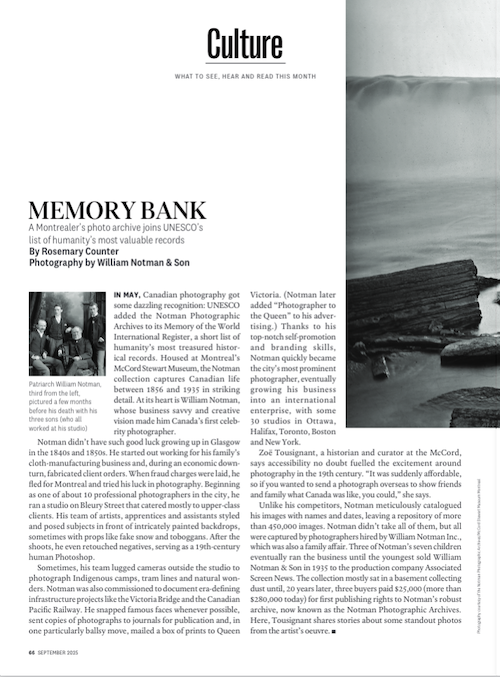Memory Bank
A Montrealer’s photo archive joins UNESCO’s list of humanity’s most valuable records
In May, Canadian photography got some dazzling recognition: UNESCO added the Notman Photographic Archives to its Memory of the World International Register, a short list of humanity’s most treasured historical records. Housed at Montreal’s McCord Stewart Museum, the Notman collection captures Canadian life between 1856 and 1935 in striking detail. At its heart is William Notman, whose business savvy and creative vision made him Canada’s first celebrity photographer.
Notman didn’t have such good luck growing up in Glasgow in the 1840s and 1850s. He started out working for his family’s cloth-manufacturing business and, during an economic downturn, fabricated client orders. When fraud charges were laid, he fled for Montreal and tried his luck in photography. Beginning as one of about 10 professional photographers in the city, he ran a studio on Bleury Street that catered mostly to upper-class clients. His team of artists, apprentices and assistants styled and posed subjects in front of intricately painted backdrops, sometimes with props like fake snow and toboggans. After the shoots, he even retouched negatives, serving as a 19th-century human Photoshop.
Sometimes, his team lugged cameras outside the studio to photograph Indigenous camps, tram lines and natural wonders. Notman was also commissioned to document era-defining infrastructure projects like the Victoria Bridge and the Canadian Pacific Railway. He snapped famous faces whenever possible, sent copies of photographs to journals for publication and, in one particularly ballsy move, mailed a box of prints to Queen Victoria. (Notman later added “Photographer to the Queen” to his advertising.) Thanks to his top-notch self-promotion and branding skills, Notman quickly became the city’s most prominent photographer, eventually growing his business into an international enterprise, with some 30 studios in Ottawa, Halifax, Toronto, Boston and New York.
Zoë Tousignant, a historian and curator at the McCord, says accessibility no doubt fuelled the excitement around photography in the 19th century. “It was suddenly affordable, so if you wanted to send a photograph overseas to show friends and family what Canada was like, you could,” she says.
Unlike his competitors, Notman meticulously catalogued his images with names and dates, leaving a repository of more than 450,000 images. Notman didn’t take all of them, but all were captured by photographers hired by William Notman Inc., which was also a family affair. Three of Notman’s seven children eventually ran the business until the youngest sold William Notman & Son in 1935 to the production company Associated Screen News. The collection mostly sat in a basement collecting dust until, 20 years later, three buyers paid $25,000 (more than $280,000 today) for first publishing rights to Notman’s robust archive, now known as the Notman Photographic Archives.
